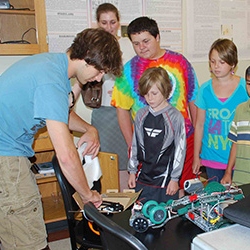Finding Flavor and Fighting Sickness in Food
Coffee and cancer aren’t often mentioned in the same sentence, but in Dr. Feng Chen’s laboratory, both are topics of much debate. On Dr. Chen’s Creative Inquiry team, students from the Department of Food, Nutrition, and Packaging Science get lab experience in a variety of food-related subjects, from analyzing the flavor of coffee to evaluating the clinical potential of certain fruit extracts. Students probe questions like, “When and why does coffee go bad?” and “Why are blueberries considered so healthy?”
Nutraceuticals, the development of a food towards medical purposes such as disease prevention, is just one of the many fields investigated by this Creative Inquiry group. The team originally started researching a set of compounds found in cottonseed oil called polyphenols. Through extraction and analysis, these polyphenols were discovered to contain a plethora of medical applications. These compounds are anti- almost anything you can imagine: antioxidant, anticancer, antiparasitic, and the list goes on. Although many of their properties are still being analyzed, these polyphenolic chemicals show good potential for future drugs.
With success using cotton, the Southern cash crop, the group started to wonder if other harvested goods held similar health-promoting properties. The team turned to blueberries and Southern-grown muscadine grapes. They were shown to have similar, but distinct polyphenols from cottonseed oil.
In these natural delectables, the students are investigating a particular subset of polyphenols called anthocyanins. Anthocyanins are part of what gives plants their red, blue, and purple colors. These chemicals are proving to be just as promising as the polyphenols found in cottonseed oil – research shows that they can fight conditions like diabetes.
Because Dr. Chen’s lab contains all the complex equipment needed to extract chemicals, his Creative Inquiry team has been able to step into new territories – the flavors of various foods. Currently, the team is investigating two of America’s favorite goodies: chocolate and coffee. Instead of using the standard method of taste testing and subjective judgment, the students are approaching these guilty pleasures in a different manner: a purely analytical one. They are using flavor chemistry, or the chemical analysis of foods for natural and artificial flavor development and enhancement, to change how we think about these refreshments. Students looked at how the chemical composition of coffee changes from 30 to 60 minutes after brewing to determine what causes coffee to go bad, giving it that universally disdained burnt taste.
Dr. Chen boasts that his lab has some of the best opportunities at Clemson University to practice proper lab technique. “Results are good, but we really encourage students to learn critical thinking but also to gain an independent capability for research and to discover how to write scientific papers.” Students are able to work with state-of-the-art instruments, such as a high-performance liquid chromatography machine and a UV-visible spectrophotometer, something that a normal undergraduate would never have the opportunity to interact with. No matter what subject the members are researching, they always take away valuable research experience.



